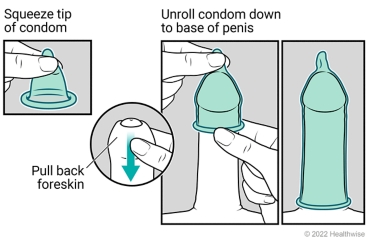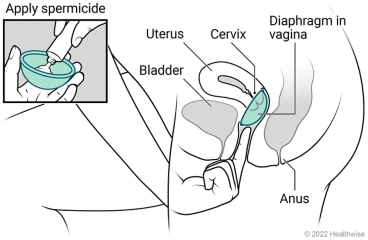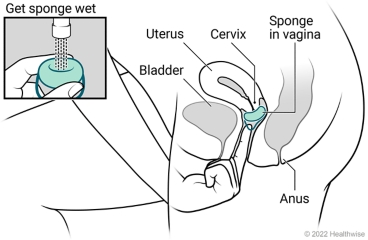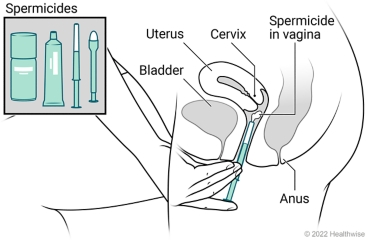Your Care Instructions
Barrier methods of birth control help prevent pregnancy by blocking sperm. This stops the sperm from reaching an egg. Types of barrier methods include external (male) condoms, internal (female) condoms, diaphragms, cervical caps, and the contraceptive sponge. Barrier methods work better when you use them with a spermicide. This is a substance that kills sperm. Spermicides come in many forms—cream, gel, foam, film, and suppository. Sometimes they are used alone as a birth control method.
In general, barrier methods don't prevent pregnancy as well as IUDs, implants, or hormonal methods. The external condom and diaphragm are the barrier methods that work best. The cervical cap and sponge work about as well as a condom or a diaphragm if you have not had a vaginal birth. But the cap and sponge don't work as well if you have ever had a vaginal birth. The internal condom does not work as well as an external condom. Use of spermicide alone does not work well to prevent pregnancy.
Condoms also protect against sexually transmitted infections (STIs) such as HIV/AIDS and herpes. Other barrier methods do not protect against most STIs.
Follow-up care is a key part of your treatment and safety. Be sure to make and go to all appointments, and call your doctor if you are having problems. It's also a good idea to know your test results and keep a list of the medicines you take.
What kinds of barrier birth control are available?
Barrier methods of birth control include these methods.
External (male) condom

An external (male) condom is a thin tube that fits over the penis. It can be made of rubber (latex), plastic, or lambskin. It prevents sperm from getting into the vagina. Rubber and plastic condoms also protect against STIs. Lambskin condoms do not protect against STIs. The condom is placed over the erect penis right before sex. A new condom must be used each time you have sex. When an external condom is used, about 13 out of 100 people who use it will have an unplanned pregnancy. You can buy condoms over the counter.
Internal (female) condom

An internal (female) condom is a thin plastic pouch that is open on one end. The closed end is placed inside the vagina. The condom lines the walls of the vagina and prevents sperm from getting into the vagina. It also protects against STIs. A new condom must be used each time you have sex. When an internal condom is used, about 21 out of 100 people who use it will have an unplanned pregnancy. You can buy internal condoms over the counter.
Diaphragm

A diaphragm is a silicone dome with a firm, flexible rim. It fits inside the vagina and covers the opening of the uterus (called the cervix). A diaphragm is always used with spermicide. The diaphragm is put in place no more than 2 hours before having sex. When a diaphragm is used, about 17 out of 100 people who use it will have an unplanned pregnancy. You need a doctor's prescription to get a diaphragm. With good care, it lasts 1 to 2 years.
Cervical cap

A cervical cap is a silicone device. It fits inside the vagina, up against the cervix. The cervical cap is always used with a spermicide. You need a doctor's prescription to get a cervical cap. How well the cap works depends on whether you have had a vaginal delivery or not. For people who have had a vaginal delivery and use the cap, about 32 out of 100 will have an unplanned pregnancy. For people who have not had a vaginal delivery, about 16 out of 100 will have an unplanned pregnancy. A cervical cap can last for up to 2 years.
Contraceptive sponge

A contraceptive sponge is a plastic foam disc. It fits inside the vagina and covers the cervix. It also releases a spermicide. The sponge is soaked with water and then placed in the vagina. After you place the sponge, you have protection for up to 24 hours. How well the sponge works depends on whether you have had a vaginal delivery or not. For people who have had a vaginal delivery and use the sponge, about 27 out of 100 will have an unplanned pregnancy. For people who have not had a vaginal delivery, about 14 out of 100 will have an unplanned pregnancy. You can buy the sponge over the counter.
Spermicide

A spermicide is a substance that kills sperm or stops sperm from moving. You can buy it as a foam, gel, cream, film, and suppository. Most spermicides come with an applicator. This is filled and put in the vagina about 15 minutes before vaginal sex. More spermicide must be used each time you have sex. Spermicide used alone does not work well to prevent pregnancy. When spermicide is used, about 28 out of 100 people who use it will have an unplanned pregnancy. It works better to use it with an external condom. You can buy spermicide over the counter.
What are the advantages of barrier methods of birth control?
Advantages of using barrier methods of birth control include the following:
- Barrier methods help protect against pregnancy. Condoms help protect against pregnancy and also STIs such as HIV/AIDS and herpes.
- They are safe to use while breastfeeding.
- They do not use hormones. So they are safe to use if you smoke or have health problems such as heart disease or blood clots.
- They do not affect the menstrual cycle. The ability to get pregnant returns as soon as these methods of birth control are stopped.
- You do not need a doctor's prescription for condoms, the contraceptive sponge, or spermicides.
What are the disadvantages of barrier methods of birth control?
Barrier methods of birth control have some disadvantages.
- They do not prevent pregnancy as well as IUDs, implants, or hormonal forms of birth control.
- They prevent pregnancy only if you use them every time you have vaginal intercourse.
- You may have to interrupt sex to use some barrier methods of birth control.
- A doctor's prescription is needed to get a diaphragm or cervical cap.
- The cervical cap and contraceptive sponge do not work as well as the other barrier methods if you have delivered a child through the vagina.
- The diaphragm and sponge can't be used by people who have had toxic shock syndrome.
- The cervical cap should not be used during a menstrual period.
Where can you learn more?
Go to http://www.healthwise.net/patientEd
Enter J114 in the search box to learn more about "Barrier Methods of Birth Control: Care Instructions".
Current as of: April 30, 2024
Author: Ignite Healthwise, LLC Staff
Clinical Review Board
All Healthwise education is reviewed by a team that includes physicians, nurses, advanced practitioners, registered dieticians, and other healthcare professionals.

